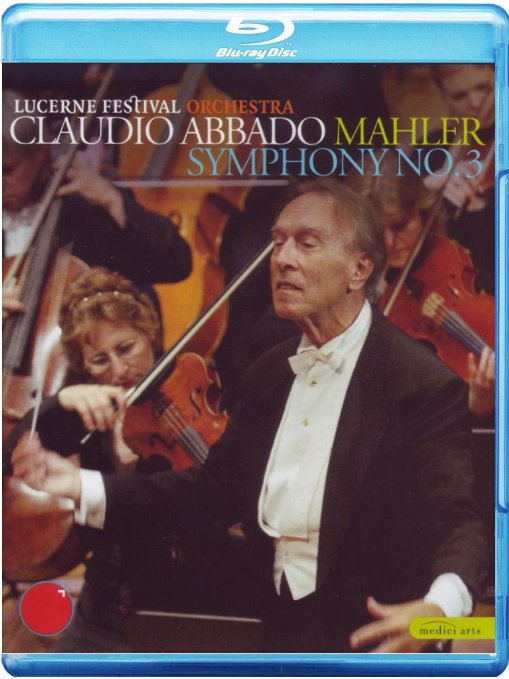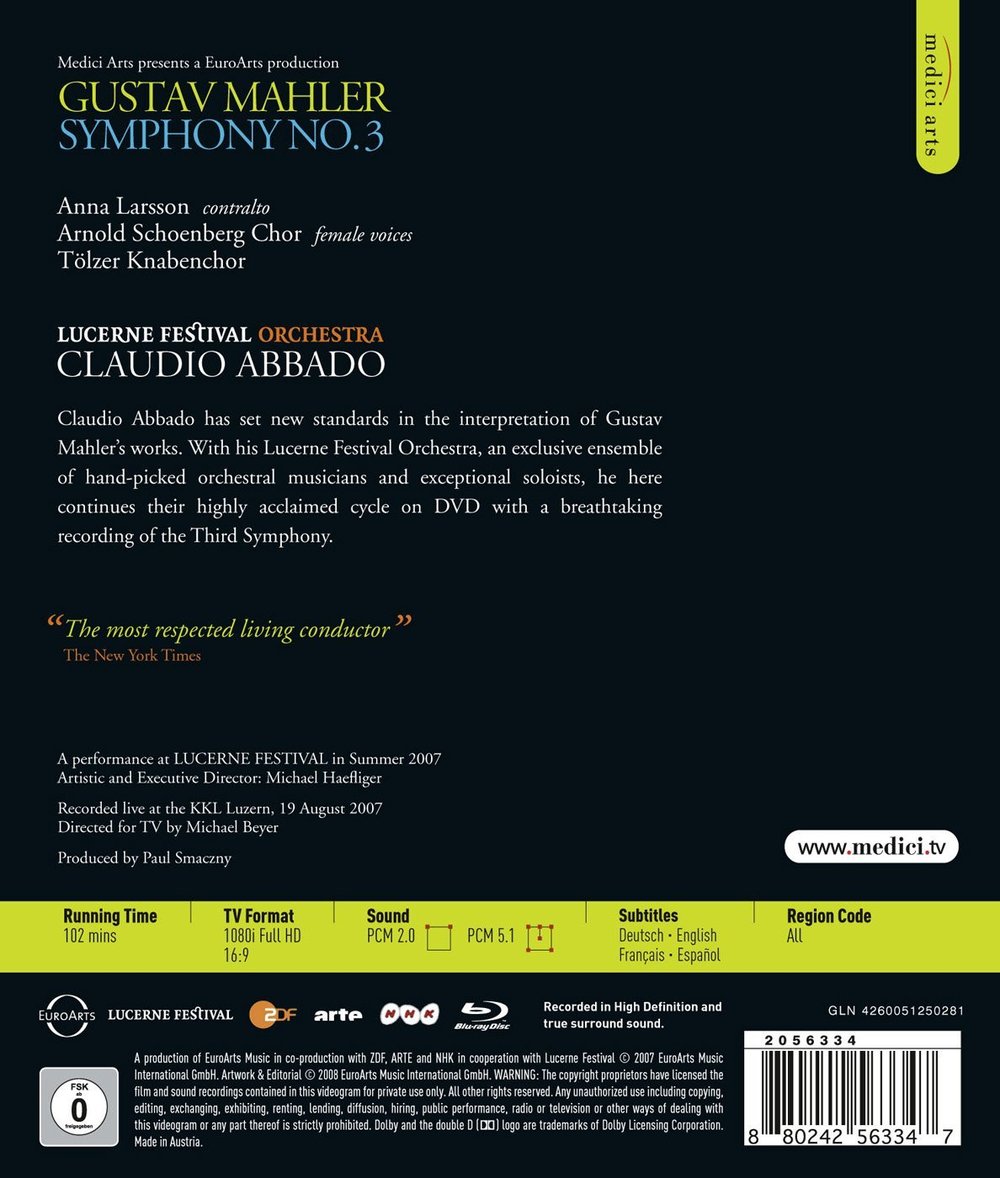

Mahler Symphony No. 3. Claudio Abbado conducts the Lucerne Festival Orchestra, the female voices of the Arnold Schoenberg Choir Vienna, and the Tölzer Knabenchor in 2007. Mezzo-soprano Anna Larson is the soloist contralto. Directed for TV by Michael Beyer. Released in 2009, this disc has 5.1 PCM sound. Grade: C+
Because this is the longest symphony in the standard repertoire (92 minutes in 2 Parts with 6 Movements), you seldom get to hear it live. It has been recorded many times on CD. There are (January 2018) a couple of old DVDs recordings of this available perhaps only at high collector-item prices. There is a Blu-ray video in the RCO Mahler 1-10 box set (graded D), and there is a horrible Blu-ray from the Frankfurt Radio Symphony Orchestra available as part of several combo packages. It would appear then that subject disc is the only Mahler Symphony No. 3 available as a stand-alone Blu-ray from a famous orchestra and conductor. M3 is perhaps Mahler's most dramatic and ambitious symphony, so it's ironic that it's so rarely performed and recorded. Back when this came out (2009), the print critics were enthusiastic about the performance, and so are we today.
But this was done early in the HDVD era, a DVD version was published also, and Michael Beyer directed the video. So its no surprise that the title suffers from a terrible case of DVDitis. In this review, I'll show you screenshots first and will follow with an analysis of the weak video content that drags down our grade. First below is a typical whole-orchestra shot—it's pretty good even if the angle is a bit too low and a few players on the flanks are missing:
The next shot below gets all the players and the angle is good. But this is not a whole-orchestra shot. The range is too far away. I call this an architectural view when it's used for valid reasons. In this video this shot appears about 7 times and is used to tell you that the sounds you are hearing come from off-stage musicians that Mahler often used to create mysterious musical effects. This shot also shows the TV cameras located to the conductor's left behind the violins and another on a left balcony. But you don't see any cameras on the right. This may explain why so many of the screenshots below were shot from the left side of the stage:
Over 50% of the video clips are small-scale like the rare shot below of the two lead viola players:
M3 has maybe the most glorious solo trombone part in classical music. For this performance, Abbado recruited Jörgen van Rijen, then the principal trombone player with the Royal Concertgebouw Orchestra, who is in the center of the next view below. We show Jörgen playing with the trumpet virtuoso Reinhold Friedrich because at that point all the brass instruments are cloaked with cloth "bag" mutes. Mahler loved unusual methods of creating special orchestra colors:
And here's a fine large-scale view of all 9 of the horns employed:
The TV director had the ability to make just about any shot he wanted from the left. Next below is a wonderful multi-section shot of the violas and cellos:
It seems this is the only shot from the right of the stage that we came up with. It shows most of the 1st and 2nd violins:
Just moments before, Anna Larsson was sitting in the empty chair and this was a nice part-orchestra shot. Two steps forward, she will start singing. This would then be a "realistic" shot of the star soloist:
We count as realistic any shot that shows the star soloist, as you see below, from the waist up. The notion is that someone in the audience sitting on the front row could see her this well:
The next view below would be realistic except that it's shot from the side. This is not something anyone in the audience could enjoy:
The last shot of Anna below is unrealistic because it's too close. We have no complaint about close-ups of the stars so long as 50% or more of the star images are realistic:
The next shot below is a conductor shot (C). It's marred by a framing error that shows the Anna's backside. But fear not. This video has 155 more shots of Abbado's torso conducting:
And the video also has 47 conductor-over-backs (C/B) shots. What exactly is that? Look at the image next below. Is the camera shooting the conductor, or the lower strings, or both? When we see an image like this, we have to wait for the clip to play out to decide. Most often, the camera that starts with this view will then slowly pan over to the conductor. So we conclude it's a C/B clip:
The next shot below is clearly a C/B shot because we see the backs of at least 10 players and the lower strings only take up about 1/3 of the image:
The next C/B shot below can induce dizziness:
And this one can cause vertigo:
And lastly in this series is the worst C/B shot of all:
When you add up all the C and C/B shots in this video, the total conductor shots equal 28% of the film. You should also know that most of the longest clips in this video focus on Abbado. We estimate that views of Abbado probably take up 35% or more of this film, which would mean you spend, say, over 31 minutes just watching Abbado beating out bars and cueing in players. You might be paying, say, $15 just to watch Abbado do this.
Now we don't denigrate the importance of the conductor. Were Abbado to miss a single beat during 90 minutes of this piece, the orchestra could get confused and the whole performance could grind to a very embarrassing stop. And Abbado has spent his whole lifetime learning how to instruct, rehearse, and lead his orchestra. But all of this takes place before the concert. The result of all this work is the what the audience sees and hears from the musicians. So is it sensible to divert more than a third of the time in the video away from the players to the conductor? We think not. So why do the TV directors do this? Well, we do know that it's hard work making well-framed shots of the many players and sections of players performing a symphony. We think that making shots of the torso of a conductor is a relatively easy task. Could it be that the TV directors and film editors devote so much time to the conductor just out of laziness?
This next view is not a C/B shot. What is it? Why, it's a backs-and-sheet-music shot (with most of the other players resting in the background):
Did the film editor really intend to leave this last angle in the video?
You might wonder where we get all the numbers we use above in this review. Well, we filled out a Symphony Wonk Worksheet.
There are 93 minutes, 55 seconds of music in this video divided into 730 video clips. This yields the pace of 7.7 seconds per clip for the whole symphony. Here is a more detailed breakdown:
Conductor shots = 156
Conductor-over-backs shots = 47
Soloist not realistic=15
*Soloist realistic=6
Solo and other small-scale clips = 367
*Large-scale clips = 33
*Part-orchestra clips = 19
*Whole-orchestra clips = 21
Instrument-only clips = 55
Other low-value clips = 1
*Other high-value clips = 10 (mostly off-stage music)
There are 89 "supershots" (add up the * numbers above of 6+33+19+21+10). So the supershots are 12% of the total clips (89/730). Conductor shots total 203 (156+47), and conductor shots use up 28% of the clips (203/730).
HDVDarts.com has established the following rules-of-thumb to identify a Blu-ray with DVDitis:
“A good symphony HDVD should have a slow pace with more than 10 seconds per video clip on average. 20 to 40% of the clips should be large-scale "supershots." Conductor shots should be less (way less really) than 20% of the clips in the video.”
Subject title flunks the pace test with the average clip running 7.7 seconds. It also fails the conductor test badly with 28% of the clips focusing on Abbado. It fails the supershots test badly with only 12%. Finally, it fails the star soloist test with only 28% realistic views. It also has 55 instrument-only shots, which is pretty flagrant. The music was recorded at 48kHz/16-bit specs, which is very close to CD quality.
Now to a grade. We start at an A+. There is no deduction for PQ or SQ. We further deduct a whole letter grade each for failing the pace test, the conductor test, and the supershot test. This brings us to a D+. We further reduce the grade for IO shots, and flunking the star soloist test to D-. We bring the grade back up to a C- for an excellent performance and further to C+ because there are so few alternate choices on the market for experiencing this great symphony. At this writing, we have, among a lot of competition, a single A+ Mahler Symphony No. 1 and a single B+ Mahler Symphony No. 2. If anyone would produce a high-quality Mahler Symphony No. 3 in Blu-ray free of DVDitis, they would have the market to themselves.
P.S. The Lucerne Festival Orchestra was a Abbado pet project. The core of the Lucerne Festival Orchestra was another group founded by Abbado, the 42-player-strong Mahler Chamber Orchestra. In addition, Abbado attracted other top players from around the world to Lucerne. Some of them you might recognize from other HDVDs. For example, Abbado leads the Orchestra Mozart in the HDVD of the Bach Brandenburg Concertos 1-6. Players from that performance who also joined Abaddo at Lucerne in 2007 include Jacques Zoon (flute), Reinhold Friedrich (trumpet), Raphael Christ (violin), Guilhaume Santana (bassoon), Alessio Allegrini (french horn), Benoît Grenet (cello), and (I think), Johanee Gonzales (bass). Also the harpist at Lucerne was Naoko Yoshino, who played with the Saito Kinen Orchestra featured in the NHK HDVD of the Mahler Symphony No. 1.
OR



















